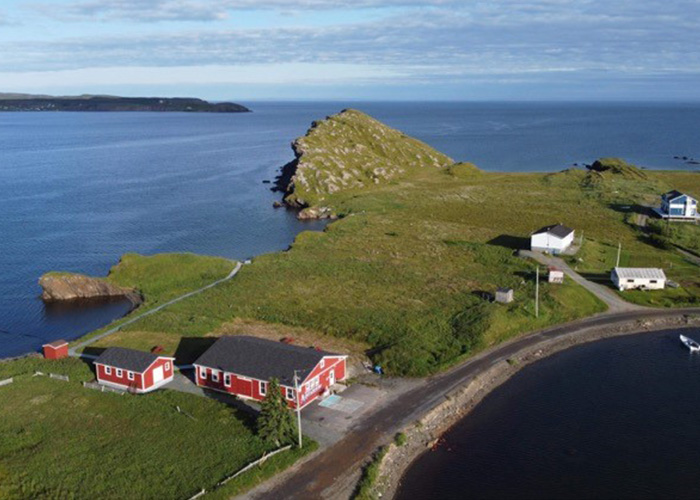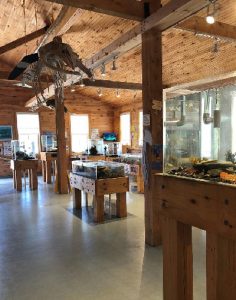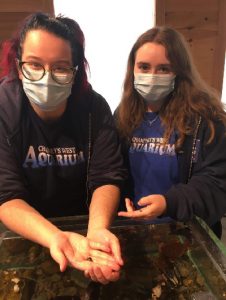DESTINATION DISCOVERED
By Kelly Foss, BBA(Hons.)’16 and Jeff Green, BA'00

YOU DON’T HAVE TO go far in Newfoundland and Labrador to find inspiration from its rugged beauty. That’s certainly the case in the Bonavista Peninsula’s Discovery UNESCO Global Geopark, which was built around discoveries by, and with support from, researchers and students from Memorial’s Department of Earth Sciences.
The Geopark, one of only five in Canada, covers an area of 1,150 square kilometres and includes 280 kilometres of coastline and landscapes.
The idea for it came from Sean O’Brien (B.Sc.(Hons.)’75, M.Sc.’79), a now retired senior geologist with the Newfoundland and Labrador Geological Survey. The region’s 560 million-year-old Ediacaran fossils were first discovered by a team that included Mr. O’Brien and Dr. Art King, a retired professor at Memorial.
Their findings attracted Dr. Duncan McIlroy, an earth sciences professor, and Dr. Martin Brasier, his former Oxford University supervisor and adjunct professor at Memorial, along with Oxford graduate students they were then co-supervising.
In a 2007 trip to the area, the group discovered a brand-new fossil, Haootia quadriformis, the oldest example of an organism to possess muscle. It is now on display at The Rooms.
Their findings brought more attention to the region and locals began to seriously consider the opportunities that could be created through geotourism, geoconservation and geoeducation.
But first, they needed to build community capacity. “Duncan, Martin and their students were able to help us expand local knowledge of the fossils and why they were important,” said Edith Samson, chair of Discovery Global GeoPark.

“They would hold lectures and talks and that was an opportunity for them to share what they were doing here, as well as build knowledge and interest, not only within our community, but also with potential funding partners.”
The region’s relationship with Memorial over the years was also a major boost in achieving the official recognition.
“With Mistaken Point getting World Heritage status, Discovery Geopark needed to find its own identity,” said Dr. McIlroy. “Discovering Haootia provided a distinct and complementary story that took the Geopark to the next level. If Mistaken Point is where life got big, the Bonavista Peninsula is where life got on the go.”
During fall 2021, Dr. McIlroy used funding from Memorial’s GradSWEP program and Discovery to send his PhD students Chris Mckean, Daniel Perez Pinedo and Giovanni Pasinetti to the Port Union region to focus on geoeducation and supporting geoconservation and geotourism efforts.
“They talked to tourism operators about local geology, and they hosted geoconservation trips for the board of Discovery to help identify sites that are safe for people to visit without causing damage to the fossils,” said Dr. McIlroy.
They also visited schools and clubs and developed new material to supplement school curriculum relevant to local geology and paleontology.
Memorial will continue to partner with Discovery as it works towards building an interpretation centre and field station, which will also support ongoing research efforts.
That same enthusiasm for science, tourism and social enterprise – combined with a commitment to communities – is found in the picturesque fishing community of Champney’s West, where Memorial also has deep roots. Many of its researchers, staff, students and alumni played an integral role in the creation of the state-of-the-art oceanfront Champney’s West Aquarium, which attracts more than 5,000 visitors a year. It is operated by a volunteer board of directors – many with ties to Memorial.
The facility includes viewing and interactive touch tanks displaying a variety of local marine life, the always-popular skeletons of a minke whale and leatherback turtle and craft shop.
Dr. Bill Driedzic, professor emeritus and former Canada Research Chair in Marine Bioscience, Department of Ocean Sciences, Faculty of Science, is one of the many people from Memorial who has a long association with the aquarium. He and his wife have owned a summer home in Champney’s West for years.
That’s where they met people like Maggie Pippy, currently completing a bachelor of technology, who grew up around the wharfs and stages of Champney’s West, collecting sea stars and periwinkles and playing near its beaches and tide pools. Her love of the ocean helped inspire the aquarium more than a decade ago.
“I loved watching sea life. I was always fascinated by how they moved or how they looked,” she explained. “Many people look out at the ocean and all they see is water. I wanted to show people what I see: the uniqueness and the beauty that lies beneath.”

Her mom, Wanda Pippy, an active community volunteer, connected with Dr. Driedzic, and other community volunteers, about developing the facility.
“Out of that seminal moment grew the Champney’s West Aquarium,” noted Dr. Driedzic.
Ms. Pippy says her long-standing connection to the aquarium has influenced her career path and “passion for ocean life.”
“I began with a love of ocean species, but after working in the aquarium I developed a desire to protect and conserve these species, and teach people about the importance of our marine environments and everything in them.”
Just as Newfoundland and Labrador’s unparalleled natural surroundings continue to inspire a new generation, those living and working there can’t wait to welcome the world back to their neck of the woods.

